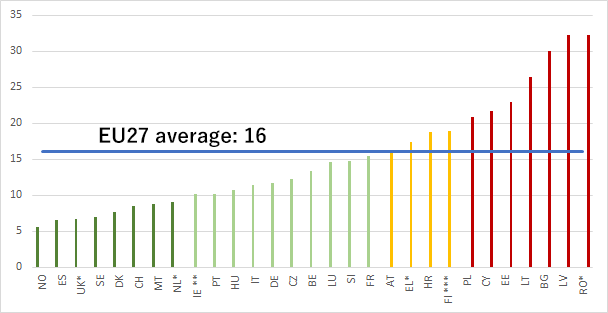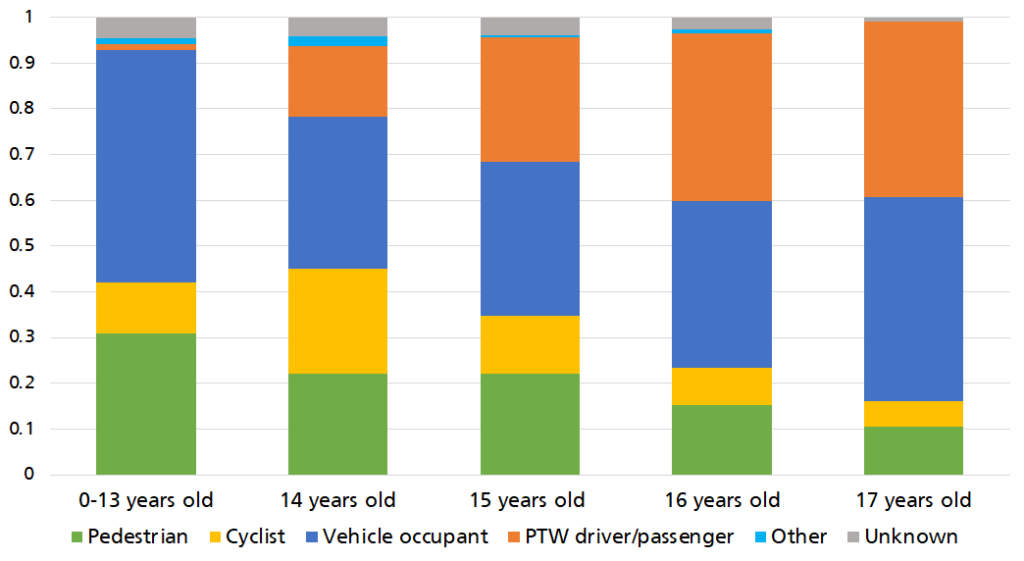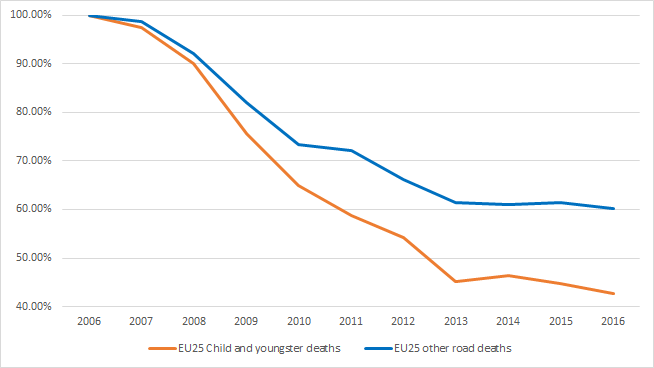The road safety of children and youngsters has improved considerably in almost all European countries over the past decade. Yet, 1,188 children and youngsters under the age of 18 were killed in the EU in 2016 alone and more than 19,500 have been killed over the last ten years. Many more sustained life-changing injuries.
The impact of these deaths and life-changing injuries on families and communities is immeasurable. But these numbers of deaths and injuries are not inevitable.
Mortality of Children and Youngsters Differs Widely across Europe
For children and youngsters in the EU, there were on average 16 killed on the road per million child and youngster (aged 0-17) population between 2014 and 2016. It should be underlined that the road death rate of 15, 16 and 17 year olds contributes to half of this figure, as the average for children up to and including 14 years old is 8 deaths per million child population.

Figure 1 – Deaths per million child and youngster (aged 0-17) population.
However, children and youngsters do not benefit from the same level of safety everywhere in Europe. The road fatality rate for children and youngsters in Norway is over 5.5 times lower than in Latvia and Romania. Countries with an overall good road safety performance also tend to have a good road safety performance for children and youngsters.population.
Mortality Increases Steeply after 13
Children aged 10-13 have higher road mortality than children aged 5-9. As part of normal child development, children aged 10-13 are more likely to move around unaccompanied by adults, in particular travelling to and from school. But once they reach the age of 14 and progressively acquire access to powered two wheelers and cars, their road mortality starts to increase steeply.

Figure 2 – Road deaths by age group per million population of each age group, averages 2014-2016 for the EU27.
Modal Shift after 13 Years of Age
To illustrate the risk of death associated with changes in modal use with increasing age figure below shows the distribution of 0-13, 14, 15, 16 and 17 year old road deaths by mode of transport over the period 2014-2016 in 25 EU countries.

Figure 3 – Proportion (%) of 0-13, 14, 15, 16 and 17 year old deaths by mode of transport in the EU25 over the period 2014-2016, 2013-2017 for 17 year old.
51% of 0-13 year old children die as car occupants, 31% as pedestrians and 11% as cyclists. Up to 14 years old, the ways in which children travel are often dictated by the choice of parents.
As from 14 years youngsters become more mobile and more independent road users. The proportion of powered two wheeler (PTW) user deaths starts to increase steeply at the age of 14. In several European countries driving licenses for mopeds can be obtained as of the age of 14.
Powered two wheeler rider and passenger deaths represent 15% of all 14 year old, 27% of 15 year old, 37% of 16 year old and 38% of 17 year old road deaths.
Children and Youngsters are Safer Today than Ten Years Ago
Over the last decade, road fatalities amongst children and youngsters have decreased
significantly in the EU. While 2,639 children and youngsters died on roads in the EU25
in 2006, the figure was 1,128 in 2016.* This represents a decrease of 57.3%, while
other road deaths have only decreased by 39.8% over the same period.

Figure 4 – Relative development in the number of road deaths for persons under 18 years old and other road deaths in EU 25 over the period 2006-2016.
* Bulgaria, Lithuania and Slovakia are excluded from these figures due to insufficient data for the full period 2006-2016. 54 children and youngsters died on roads in Bulgaria in 2016 and 6 in Lithuania, bringing the total road deaths under 18 years in 2016 to 1188, as mentioned in the introductory paragraph.